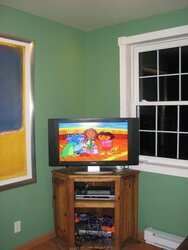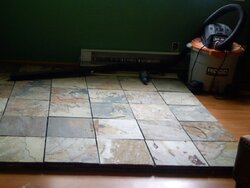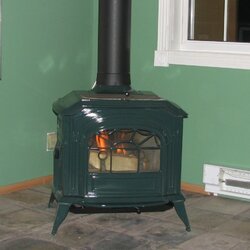I am about to build my hearth and have a few last questions to ask all you knowledgeable folks before it is too late.
The stove being installed is a VC resolute acclaim with back and bottom heat shields and double wall piping - it is a corner install.
1) The stove is going to be placed Near a window - due to the layout of the room and placement of the all-important TV. Is this a problem and are there any special considerations that need to be taken in?
The dealer said that as long as the stove has 15 inches back clearance from the outermost point of the wall it should be fine. I am taking the outermost point to be the baseboard heater.
Nothing sticks out further than that.
2) I am planning to build a subfloor of 1/2 inch PLywood fastened with deck screws directly to the floating floor, 1 layer of Durock fastened with Durock screws, mortar and Slate tile.
3) The resolute door is just shy of 22 inches - code here is for 18 inches of floor protection in front of the stove - although the dealer recommended to go 22 for extra protection and even more if I have room for it.
Install date is 1 1/2 weeks away - so I have time enough - just want to make sure my plans are in good order first.
Problems? Comments? Suggestions?
The stove being installed is a VC resolute acclaim with back and bottom heat shields and double wall piping - it is a corner install.
1) The stove is going to be placed Near a window - due to the layout of the room and placement of the all-important TV. Is this a problem and are there any special considerations that need to be taken in?
The dealer said that as long as the stove has 15 inches back clearance from the outermost point of the wall it should be fine. I am taking the outermost point to be the baseboard heater.
Nothing sticks out further than that.
2) I am planning to build a subfloor of 1/2 inch PLywood fastened with deck screws directly to the floating floor, 1 layer of Durock fastened with Durock screws, mortar and Slate tile.
3) The resolute door is just shy of 22 inches - code here is for 18 inches of floor protection in front of the stove - although the dealer recommended to go 22 for extra protection and even more if I have room for it.
Install date is 1 1/2 weeks away - so I have time enough - just want to make sure my plans are in good order first.
Problems? Comments? Suggestions?




